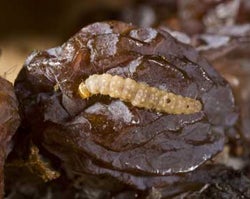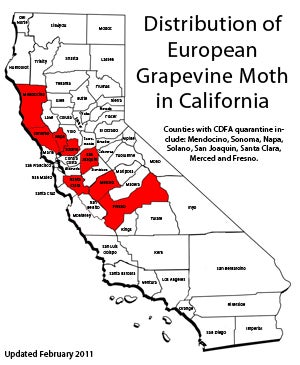European grapevine moth, Lobesia botrana (Lepidoptera: Tortricidae)
The Situation: The European grapevine moth (EGVM) is native to southern Italy, but is also found throughout Europe and in some regions of Africa, the Middle East, Russia, Japan, and Chile. Initial detection of European grapevine moth in the United States occurred in Napa County, California, in 2009. Arrival of this insect poses a significant threat to the state’s grape production capacity because the moth’s larvae feed on grape flowers and fruits. As of 2010, a quarantine is operational in several California counties in an attempt to stop the spread of EGVM to surrounding areas.
Damage: It should be emphasized that the larvae, rather than adult European grapevine moth, are responsible for the most severe damage to grapevines. Over the course of the season larvae preferentially feed on and damage developing grapevine flower clusters, immature berries, and mature berries. Late in the season, damage is compounded because larval feeding damage increases grape cluster vulnerability to fungal infections, most likely caused by the pathogen Botrytis cinerea.
Although grapevines are a preferred plant, European grapevine moth is reported to feed on a wide range of fruit and ornamental plants, including: blackberry, bladder campion, carnation, currant, European barberry, European privet, false baby’s breath, gooseberry, jujube, kiwi fruit, old-man’s-beard or traveler’s joy, olive, persimmon, pomegranate, red clover, rosemary, sea squill, spurge flax, St. John’s wort or Klamath weed, and various stone fruits.
Life Cycle: Adult European grapevine moth females are capable of laying 35 eggs per day for approximately 6 days. Hatching of eggs occurs anywhere from 3 days to 1 and a half weeks after they were laid, depending on ambient temperatures. It takes approximately 3 to 4 weeks for young larvae to fully mature, and it is during this stage of its life that European grapevine moth causes the most damage to grapevines. The pupal stage lasts an additional 1 to 2 weeks, after which adults emerge. Typically, adults will live for about 1 to 3 weeks. Multiple generations of EGVM frequently occur in a growing season, with reports of up to 4 generations in a single year being possible in areas with favorable climates and food. European grapevine moth overwinters as a pupa, constructing cocoons in the bark of grapevines or in soil cracks. First-generation adults emerge from pupation when temperatures become warm, usually in the middle of spring.
Distribution: The European grapevine moth is native to southern Italy, but has expanded its range throughout most of Europe and into regions of the Middle East and Russia. It has also been reported in parts of Africa, Japan, and Chile.
In the United States, EGVM was first detected in Napa County, California, in late 2009. Since then this invasive insect has been found in at least nine counties of California. Soon after the initial detection quarantine procedures were put in place to contain its spread. The regions affected include parts of the following counties: Fresno, Lake, Mendocino, Merced, Monterey, Napa, San Joaquin, Santa Clara, Solano, and Sonoma counties. The quarantine order describes guidelines for the proper transportation and disposal of grapes and other favored plant species.
Control: Currently, available management strategies for the European grapevine moth include chemical control, mating disruption, and fruit removal. Insecticides approved for use on the European grapevine moth include insect growth regulators, spinosyns, and Bacillus thuringiensis (Bt). There is currently at least one mating disruption product available which works by mimicking female European grapevine moth pheromones, resulting in adult males becoming disoriented and thereby delaying or preventing their mating with receptive females. Fruit removal from infested and surrounding grapevines has been prescribed as a first step control measure for both homeowners and commercial growers in affected areas. Research to identify a viable European grapevine moth biological control agent is ongoing. In its native range parasitoids that attack the pupal stage are reportedly effective at suppressing this pest.
More Media on the European Grapevine Moth
UC IPM Online: European Grapevine Moth: Provisional Guidelines
Napa County UCCE: European Grapevine Moth
Center for Invasive Species Research, University of California Riverside
Text provided by Barrett Gruber and Matt Daugherty, Assistant Extension Specialist at University of California.
Images courtesy of Jack Kelly Clark.
Matt Daugherty, Assistant Extension Specialist
matt.daugherty@ucr.edu
Personal Website



